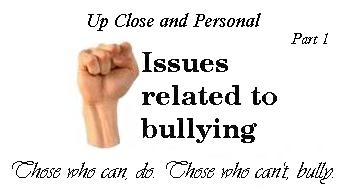Up Close and Personal - Part 1
 Experts at Kansas State University say, "Cyberbullying consists of a person who uses the anonymity of the Internet to ridicule, make fun of or put down another person on an Internet conversation site, such as a chat room, a bulletin board, Myspace or Facebook."
Experts at Kansas State University say, "Cyberbullying consists of a person who uses the anonymity of the Internet to ridicule, make fun of or put down another person on an Internet conversation site, such as a chat room, a bulletin board, Myspace or Facebook."The vast majority of online resources that probe this topic are mostly compiled with the adolescent age group in mind. But the one common theme that resonates throughout various articles related to cyberbullying, regardless of age, is defined in an article published by http://www.newswise.com/.
"At the heart of any bully is actually a coward who uses their advantage to humiliate, demean or embarrass. Instead of working on their own issues, bullies pick on others to feel better about themselves," said Tony Jurich, Kansas State professor of family studies and human services. "The difference is the cyberbully gets more coverage and a wider exposure. One catty remark can hit thousands of people in a very short amount of time."
The newswise article concludes with the following inference by Mike Ribble, instructor in the department of educational leadership and instructional services coordinator/Web coordinator in the College of Education.
"As a society, we can't push technology aside and say these problems don't exist. We have to recognize the potential danger that could lie in the future if we do not prepare for the next generation. Technology has the potential to bring people together, but it also has the ability to divide."
Those who have been targets of cyberbullies will most likely agree with Mike Ribble’s judgment, but how does society as a whole take steps to eliminate offensive Internet behavior? An article on http://www.pta.org/ addresses the legal issues surrounding The Newest Breed of Bully, the Cyberbully.
Charting new legal territory
“Because cyberbullying is such a new phenomenon, school and law enforcement officials in the United States and other countries are still sorting out the legal technicalities. "Most of what is done online is protected as free speech," says Frannie Wellings, policy fellow at the Electronic Privacy Information Center in Washington, DC.
In contrast to print publications, where individual stories are checked for libel and accuracy, the atmosphere surrounding websites is freer. "An editor of a newspaper or magazine has to make a conscious decision about what happens in his pages," observes Wellings. "There is a lot of history on what has happened to publishers who were sued," she adds. Because of the vastness of cyberspace, few screening mechanisms exist. "Imagine the bureaucracy of policing everything online," says Wellings. "An Internet Service Provider [ISP] would have to go to great lengths and spend a lot of money." As a result, most ISPs maintain that they are merely a conduit for individuals who want to post information online. Most ISPs have policies telling people not to post offensive material, but that warning is often ignored.
While some of what is published online may seem libelous (i.e., intended to harm the reputation of another), proving that point can be difficult and expensive. In order to prove libel, you have to prove malicious intent, something that might prove difficult if the offending Web page was put up by an adolescent. And many times, freedom of speech wins out.
Unless an actual crime has taken place, law enforcement officials often are unable to arrest anyone, even if they can identify the culprit. According to Lt. John Otero, commanding officer of the computer crime squad for the New York City Police Department, individuals would actually have to post a direct threat in order for the police to act. "For example, if they say, 'tomorrow I am going to hurt, kill, or injure an individual,' that would constitute a crime," he explains. A person posting such a threat could be arrested and charged with aggravated harassment. Although Otero says his department has seen some arrests, anyone under the age of 18 would not be dealt with harshly: "If the kid is too young, he would get a scolding and the incident would be brought to the parents' attention; if they are under 16, they are considered minors."
Most of what police departments see, however, does not constitute an actual crime. "What we get is a lot of 'he said, she said,' not unlike what you would find in the boys' room, only now they are doing it using electronics," says Otero.”
http://tinyurl.com/yml2uc
~~~~~~~~~~~~~~~
A recent study of 1,500 students in fourth through eighth grades was conducted by 1-Safe America, an organization that promotes Web safety. Forty-two percent of respondents said they had experienced malicious bullying online.
And 58 percent of them hadn't told their parents.
Alarming statistics that adult bullies should heed!
How would they feel if someone targeted people they care about?
Will they condone the type of behavior they themselves engaged in?
i-SAFE America Inc. is a non-profit foundation whose mission is to educate and empower youth to safely and responsibly take control of their Internet experiences. The goal is to provide awareness and knowledge that enables students to recognize and avoid dangerous, destructive, inappropriate or unlawful online behavior and to respond appropriately. www.isafe.org
~~~~~~~~~~~~~~~
The Brazilian psychopath won't give up!
c9510f03.virtua.com.br
IP Address: 201.81.15.3
Country: Brazil
Returning visits: 46
2nd December 2006 - 07:17:18 AM
www.haloscan.com/comments/
babygirlsbrutus/116491905694119027



<< Home